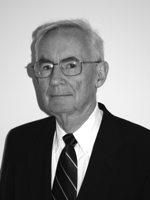2000 Karl Meyer Award Winner
Phillips Wesley Robbins was born in 1930, in Barre, Massachusetts. He graduated from DePauw University in 1952 with an A.B. and received his Ph.D. in biochemistry from the University of Illinois in 1955. After finishing his Ph.D. research, he became a research associate for Nobel Laureate and Journal of Biological Chemistry (JBC) Classic author Fritz Lipmann (1) at the Massachusetts General Hospital. Working with Lipmann, Robbins studied how ATP was used in the activation and transfer of sulfate and showed that the thermodynamic potential for the process came directly from ATP. This discovery made a large contribution to the general understanding of the global sulfur cycle, and as a result Robbins received the Eli Lilly Award in Biochemistry in 1956. The next year, Lipmann moved to the Rockefeller Institute, and Robbins joined him as Assistant Professor where he continued his work on sulfur activation. In 1960, Robbins became Assistant Professor of Biochemistry at the Massachusetts Institute of Technology. There, he met Nobel Laureate Salvador Luria, who had just discovered that the structure of Salmonella lipopolysaccharide (LPS) was controlled by lysogenic bacteriophage. Over the next several years, Robbins solved the structure of LPS and showed that the repeating units of the polysaccharide were preassembled on a polyisoprenoid lipid carrier that was eventually named bactoprenol. Robbins then elucidated the cycle involved in polysaccharide assembly. After working on bactoprenol, Robbins turned to mammalian N-linked glycosylation. The formation of N-glycosidic linkages of eukaryotic glycoproteins was known to involve the transfer of a common precursor oligosaccharide from a lipid carrier (dolichol) to an asparagine residue in the nascent polypeptide chain. In many organisms, the lipid-linked precursor had the composition Glc3Man9GlcNAc2. Robbins set out to identify and characterize the genes involved in the early steps of the dolichol-linked oligosaccharide assembly. To do this, he used Saccharomyces cerevisiae mutants that were blocked in the synthesis of the lipid-linked oligosaccharide, its co-translational transfer to protein, and the first steps of post-translational processing. The JBC Classic reprinted here describes Robbins' procedures for isolating temperature-sensitive mutants in asparagine-linked glycosylation as well as his characterization of one of these mutants (algl-1). Robbins and Tim C. Huffaker showed that algl-1 cells were able to synthesize GlcNAc2-lipid but were unable to synthesize any mannose-containing oligosaccharide-lipids. The algl-1 cells were also unable to elongate exogenous GlcNAc2-lipid but were able to convert Man1GlcNAc2-lipid to Man5GlcNAc2-lipid. These results indicated that the algl-1 mutant was blocked at the addition of the fist mannose residue to the oligosaccharide-lipid. Characterization of the Glc3Man9GlcNAc2-lipid had shown that only the mannose residue attached to GlcNAc exists in a β-D-linkage, thus indicating that the mutant had a deficiency in the enzyme involved in this process. Robbins subsequently identified and characterized several other genes in this pathway. These yeast genes were eventually shown to have orthologs in mammals. The enzymology and genetics of the dolichol pathway enzymes represent classical pieces of glycobiology history. Robbins' later research turned to the dynamics of yeast cell wall synthesis and remodeling, focusing on chitin synthesis. In 1998, he joined the newly formed Department of Molecular and Cell Biology at the Boston University School of Dental Medicine (BUSDM) where he continued his research on chitin synthesis as well as the evolution of N-linked glycosylation. In recognition of his contributions to science, Robbins has received many awards and honors. These include the Karl Meyer Award for Lifetime Achievement in Glycobiology (2000) and election to the National Academy of Sciences (1986). |

 Phillips W. Robbins
Phillips W. Robbins